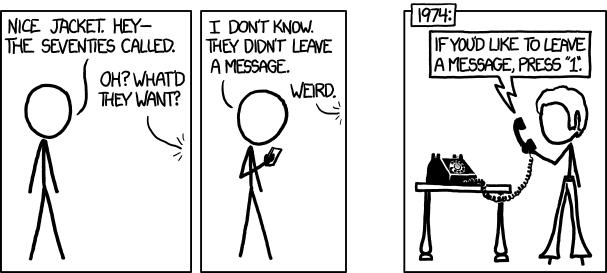1072: Seventies
| Seventies |
 Title text: Hey, man, the 1670s called. They were like 'Wherefore this demonic inſtrument? By what ſorcery does it produce ſuch ſounds?" |
Explanation[edit]
This is a take on the common insult "<year> called and they want their <item> back", used when one is wearing something out of fashion (used before in 875: 2009 Called). In this case, the comment is literally true: someone in the '70s called, but did not leave a message. Instead, the caller is puzzled because answering machines and especially voicemail were rare or nonexistent in the 1970s, and his telephone has a rotary dial, rather than a touch tone, so he can't "press" 1.
The caller is wearing flared ("bell bottom") trousers, which are frequently associated with 1970s fashion. The caller is somehow using time travel to directly dial a number in the present.
Originally telephones had rotary dials instead of buttons, hence the origin of the terms "dial tone" and "to dial a number". Touch tone phones were introduced in the 1960s, but weren't standard in many places until the 1980s. Rotary dial telephones used pulse dialing to transmit numbers and push-button telephones use DTMF (although phones from the '80s and '90s could often use both). Modern voicemail systems regularly don't support pulse dialing, so even selecting "1" on the rotary dial would not choose "1" in the voicemail menu system.
The title text plays off the fact that the telephone had not yet been invented in the 17th century: in fact, all of the component technologies, including the materials used for the casing, were unknown at that point, and therefore the telephone is assumed to be supernatural in origin ("demonic... ſorcery"). Randall uses the character "ſ", the long s, which was used in written English to take the place of the modern lowercase "s" in the beginning and middle of words. It was phased out around the beginning of the 19th century.
Transcript[edit]
- Cueball: Nice jacket. Hey–
- Cueball: The seventies called.
- Out-of-panel: Oh? What'd they want?
- [Cueball looks at his smartphone, holding it in his hand.]
- Cueball: I don't know. They didn't leave a message.
- Out-of-panel: Weird.
- 1974:
- [A person in bell bottoms, who has no jacket, looks at a rotary phone receiver.]
- Voicemail service: If you'd like to leave a message, press "1".
Discussion
Can someone comment on the S-es in image's title text? I can read it, but don't know what they mean. Probably some old spelling.
Done Blaisepascal (talk) 16:52, 13 August 2012 (UTC)
http://en.wikipedia.org/wiki/Long_s
Answering machines certainly had been invented by the 1970s (http://en.wikipedia.org/wiki/Answering_machine). The first practical commercial models started appearing in the 1960s and I had one that used an endless reel of magnetic tape in the 70s. Jonat (talk) 16:20, 6 December 2012 (UTC)
Touch tone phones were certainly around in 1974, although dial phones were still prevalent. Touch Tone dialing was introduced in the late 60s (it was a sufficient novelty that if you visited someone with TouchTone, they'd show it off) The "press 1" aspect came much later, with automatic voice response (AVR) systems, probably mid 80s, although dial phones were still in use ("or wait to be connected to an operator"). As noted by Jonat, answering machines with cassettes, loops, or reel to reel tapes were quite common in the 70s, as a result of the Carterfone decision allowing interconnection to the public switched system in the US.71.177.151.10 04:56, 22 January 2013 (UTC)Jim Lux
I've never encountered those "press 1 to leave a message"-type answering machines, only ones where it says: "[person you wanted to call] is not available at this moment. Please leave a message after the beep. *beep*". Maybe it's a US thing. 108.162.231.223 11:59, 8 December 2013 (UTC)
- Most voicemail systems here in the US, you just leave a message after the beep, and press 1 at the end for more options afterward before sending your message (e.g., to delete it and re-record). Some answering machines, though, (like the one on my landline) let a caller choose from several mailboxes by pressing a mailbox number during the outgoing message (e.g., "To leave a message for Aaron, press 1. To leave a message for Bob, press 2."). Most likely, Randall's just taking a small liberty to make the joke work. --Aaron of Mpls (talk) 20:20, 20 December 2013 (UTC)
- I've used a dial phone on those sorts of machines. Dialing "1" (or whatever number it was) worked fine, surprisingly. But evidently the person on the other end of the phone is baffled, and hasn't tried the obvious. 162.158.6.128 20:44, 22 December 2020 (UTC)
Why does this revision say he has an incredulous look on his face, when he doesn't have a face? 108.162.216.30 03:04, 20 June 2014 (UTC)
- I've seen many incredulous chins in my time, and that chin reeks of incredulity. Kev (talk) 22:45, 17 January 2015 (UTC)
Anyone care to comment on why the alttext starts the quote with a single quote (UK-style, "'") and ends with a double (US-style, '"')? Was that a thing in the 17th century? Hppavilion1 (talk) 00:57, 9 September 2016 (UTC)
The image file seems to be missing here. Can someone look into it? RamenChef (talk) 13:39, 9 March 2017 (UTC)
- Thanks for bringing this up. The picture was removed in 2012. Maybe copyright.--Dgbrt (talk) 18:41, 9 March 2017 (UTC)
the title-text looks like "Wherefore this demonic inftrument? By what forcery does it produce fuch founds?"
- That is called a "long S" https://en.wikipedia.org/wiki/Long_s Steve (talk) 06:13, 10 June 2021 (UTC)
